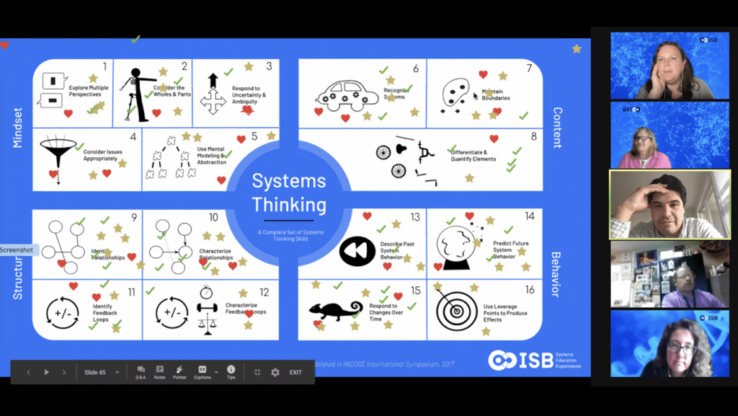
ISB Education Takes Virtual Road Trips to Offer Skills, Experience for Teachers
Since October, 50 high school teachers representing several school districts across Washington have participated in a series of ISB workshops. “We quickly realized we were in a unique position to help educators pivot into remote teaching,” said Caroline Kiehle.
SEP8 Science and Engineering Practice 8 – Obtaining, Evaluating and Communicating Information
Any education in science and engineering needs to develop students’ ability to read and produce domain-specific text. As such, every science or engineering lesson is in part a language lesson, particularly reading and producing the genres of texts that are intrinsic to science and engineering. (NRC Framework, 2012, p. 76) Being able to read, interpret, and produce scientific and technical text are fundamental practices of science and engineering, as is…
SEP7 Science and Engineering Practice 7 – Engaging in Argument from Evidence
The study of science and engineering should produce a sense of the process of argument necessary for advancing and defending a new idea or an explanation of a phenomenon and the norms for conducting such arguments. In that spirit, students should argue for the explanations they construct, defend their interpretations of the associated data, and advocate for the designs they propose. (NRC Framework, 2012, p. 73) Argumentation is a process…
SEP6 Science and Engineering Practice 6 – Constructing Explanations and Design Solutions
Science and Engineering Practice 6 – Constructing Explanations and Design Solutions “The goal of science is the construction of theories that provide explanatory accounts of the world. A theory becomes accepted when it has multiple lines of empirical evidence and greater explanatory power of phenomena than previous theories.”(NRC Framework, 2012, p. 52) Asking students to demonstrate their own understanding of the implications of a scientific idea by developing their own…
SEP5 Science and Engineering Practice 5 – Using Mathematics and Computational Thinking
Although there are differences in how mathematics and computational thinking are applied in science and in engineering, mathematics often brings these two fields together by enabling engineers to apply the mathematical form of scientific theories and by enabling scientists to use powerful information technologies designed by engineers. Both kinds of professionals can thereby accomplish investigations and analyses and build complex models, which might otherwise be out of the question. (NRC…
SEP4 Science and Engineering Practice 4 – Analyzing and Interpreting Data
Once collected, data must be presented in a form that can reveal any patterns and relationships and that allows results to be communicated to others. Because raw data as such have little meaning, a major practice of scientists is to organize and interpret data through tabulating, graphing, or statistical analysis. Such analysis can bring out the meaning of data—and their relevance—so that they may be used as evidence. Engineers, too,…
SEP3 Science and Engineering Practice 3 – Planning and Carrying Out Investigations
Students should have opportunities to plan and carry out several different kinds of investigations during their K-12 years. At all levels, they should engage in investigations that range from those structured by the teacher—in order to expose an issue or question that they would be unlikely to explore on their own (e.g., measuring specific properties of materials)— to those that emerge from students’ own questions. (NRC Framework, 2012, p. 61)
SEP2 Science and Engineering Practice 2 – Developing and Using Models
Modeling can begin in the earliest grades, with students’ models progressing from concrete “pictures” and/or physical scale models (e.g., a toy car) to more abstract representations of relevant relationships in later grades, such as a diagram representing forces on a particular object in a system. (NRC Framework, 2012, p. 58) Models include diagrams, physical replicas, mathematical representations, analogies, and computer simulations. Although models do not correspond exactly to the real…
SEP1 Science and Engineering Practice 1 – Asking Questions and Defining Problems
Students at any grade level should be able to ask questions of each other about the texts they read, the features of the phenomena they observe, and the conclusions they draw from their models or scientific investigations. For engineering, they should ask questions to define the problem to be solved and to elicit ideas that lead to the constraints and specifications for its solution. (NRC Framework 2012, p. 56) Scientific…
CCC7 Crosscutting Concept 7 – Stability and Change
For natural and built systems alike, conditions of stability and determinants of rates of change or evolution of a system are critical elements of study. Stability and Change are the primary concerns of many, if not most scientific and engineering endeavors. “Stability denotes a condition in which some aspects of a system are unchanging, at least at the scale of observation. Stability means that a small disturbance will fade away—that…


